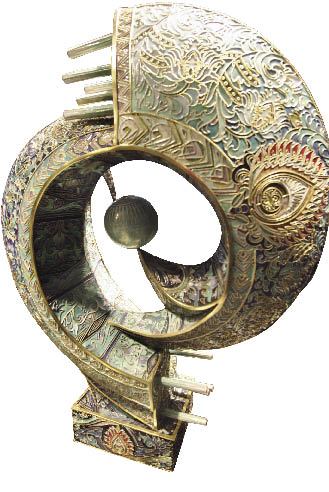|
However, filling them only one time is just the beginning. Fired in the kiln where the temperature can reach 1,000oC, the copper filaments are welded to the mold, but the pigments contract. Artisans have to refill and refire for three or four times before running a fine emery board over the filigrees and fillings to smooth any surface roughness. Then the color surface is polished once more with a whetstone, and finally to a glossy patina with charcoal. The temperature of the kiln must be controlled accurately for any mistake could cause a change of color and result in a defective ware. Last but not least, the product needs to be gilded so that the metal parts will not get rusty.
This complex manufacturing procedure finally makes the resplendent handicraft of Jingtai Blue: exquisite but with a sturdy body, well-designed inlays as well as bright colors, and bound in a glossy golden skeleton.
 |
|
The most lusterous appearance is only achieved after many rounds of careful polishing. |
Chinese Heritage for the World
The vivid patterns and fine workmanship of Jingtai Blue has always been highly praised at home and abroad. The craft won top honors at the Chicago World's Fair in 1904 and the Panama International Fair in 1915.
Jingtai Blue has also greatly influenced enamel-making in other countries. For several hundred years following the Ming Dynasty, imperially-commissioned seafaring helped to spread the technology beyond China. Even today, one can find similarities in the making of Jingtai Blue and Japanese pottery.
Nevertheless, cloisonné manufacture met its all-time low in the time of war and disorder that marred the first half of the 20th century. After the People's Republic of China was established in 1949, the government set about protecting this precious heritage. In 1956 the Beijing Cloisonné Factory was founded by merging 42 small workshops in the city.
Nowadays, craftsmen are working hard passing this skill down to younger generations while reintroducing the artistry to the modern sensibility. With the help of more colorful pigments and sophisticated machines, artisans are creating simply gorgeous new Jingtai Blue products. In addition to traditional patterns with auspicious connotations, new designs depict a peaceful life and the harmony of nature.
The most renowned artisans Zhang Tonglu, Huo Tiejun and Li Xinmin are formally recognized as State Arts and Crafts Masters by the government. Having been devoted to Jingtai Blue manufacture for nearly half century, these artisans have created a large variety of superb cloisonné works that maintain the feel of traditional art while appealing to modern tastes.
 |
|
A cloisonné made by Zhang Tonglu. |
Zhang Tonglu initiated "cloisonné painting," which makes use of the technique of Jingtai Blue but visually resembles Chinese ink and wash painting or Western oil painting. His works Friend from Afar and Great Wall Vase won gold medals at the Second and Third Chinese Arts and Crafts Fair of 2001 and 2002. Huo Tiejun often borrows the dazzling patterns of ethnic minority groups and combines them with conventional designs, giving his works a unique appeal. Li Xinmin's works cover various fields: his two-meter-tall statue of Goddess of Mercy is regarded as a national treasure; the series Beijing Impression depicts the street scenes of the capital in an abstract style; and he also used his mastery to create the figures in literature classic A Dream of Red Mansions. Besides churning out works from their studios, these masters are also busy teaching and setting up workshops to help launch the careers of student-successors.
In 2006, the technique of Jingtai Blue was approved as a national intangible cultural heritage by the Chinese government. Often in recent decades, works of the craft have been presented as national gifts to foreign state leaders. | 